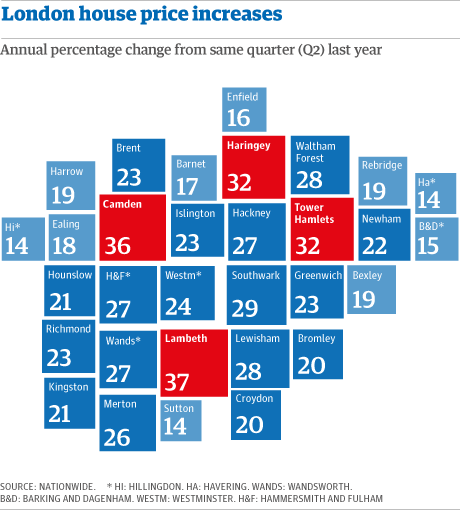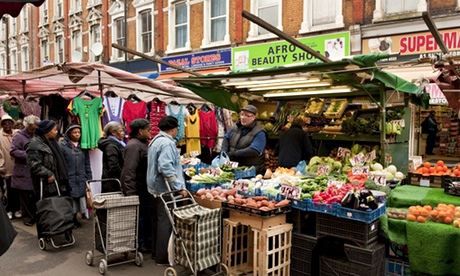The average price of a property in London has leapt by more than a quarter over the past year, a rate of growth unequalled since the summer of 1987, according to the latest figures from the UK's largest building society.
Prices in the capital rose by 25.8% between the second quarter of 2013 and the same period this year, Nationwide said, pushing the average to £400,404, the first time it has topped £400,000 and 30% higher than the peak reached in 2007.
The figures are likely to fuel fears of a price bubble in the capital, and come days after the Bank of England's Financial Policy Committee (FPC) said it would not take immediate action to constrain the housing market.
Property experts said this level of price growth was unsustainable with one warning that "the risk of a damaging house price correction at some point in the next few years is growing".
The data, which is based on mortgages approved by Nationwide over the quarter and adjusted to reflect the cost of a typical house, showed double-digit growth in all London boroughs.

In Lambeth, the south London borough that includes Vauxhall, Brixton and parts of Clapham, prices were 37% higher in the second quarter of 2014 than a year previously, while in Camden in north London they were up by 36%.
The lowest growth rate in the capital was in Barking & Dagenham, where prices increase by 15% year-on-year.
Nationwide's figures show the gap between London and the rest of the country has continued to widen, with average prices over £100,000 more than the next most expensive region, the Outer Metropolitan commuter belt, and more than double the UK average.
Separate monthly figures from the society showed the average price across the UK is less than half the London level, at £188,903, while the annual rate of price inflation is 11.8%. While the overall average is now above the peak previously reached in 2007 before the financial crisis, if London is stripped out it remains 0.4% off its previous high.
However, Nationwide said the annual pace of growth in London was likely to slow given the high base for comparison from the third quarter of 2013 and anecdotal evidence from surveyors and estate agents that activity may be slowing.
The society's figures for the second quarter of 2014 showed price rises in all regions of the UK except Scotland, where prices remained flat between the first three months of the year and the second.
When compared with the same period of 2013, prices were up strongly across the board, with Scotland recording the lowest increase, at 5.4%. In Northern Ireland they were up by 8.4%, but the average of £117,150 is still around half the level reached in 2007.
Monthly price figures from the society suggest the market stayed strong in June, despite signs of a slowdown in mortgage activity following the introduction of new lending rules in April.
Nationwide said prices were up by 1% over the month, compared with a rise of 0.7% in May.
On Thursday, the Bank of England announced a wait-and-see approach to the housing market, recommending restricting the amount of lending banks and building societies can do at more than 4.5 times an applicant's income, and forcing them to check that borrowers can still afford repayments if interest rates rise by 3%.
Nationwide's chief economist, Robert Gardner, said these moves were "unlikely to have a significant impact" on housing transactions or the pace of price growth in the near term, but would provide longer-term stability.
"These policy measures, along with previous actions, such as the introduction of mortgage market review (MMR) measures, should help to limit the risk of house prices becoming detached from earnings without de-railing the recovery in the wider housing market," he said.
"Mounting expectations that interest rates may rise earlier than previously anticipated may also act to dampen housing market activity in the months ahead."
However, he added: "It is important to note that the FPC does not have the tools to address the fundamental problem in the housing market – the lack of supply.
"While there are encouraging signs that the pace of construction has picked up, the pace of house building is still well below the expected pace of household formation."
Alexander Gosling, managing director of the online estate agents Housesimple.co.uk, said price rises in London had moved from the breathless to the breakneck.
"If anything shouts 'unsustainable', it's annual price inflation of 26%. Such frothy excess hasn't been seen since the peak of the late 1980s boom," said Gosling.
"With prices now 30% past their 2007 peak and rising by an incredible 7.6% a quarter, the capital's property market is clearly living in its own supercharged bubble. It's too soon to talk of London price rises going off the boil, but the heat may finally be at maximum."
Matthew Pointon, property economist at Capital Economics, said an imbalance between supply and demand meant prices were still rising even though the number of mortgages approved had fallen in recent months.
"While the level of debt may not be accelerating, the amount people are borrowing compared to their incomes is already at record highs," Pointon said. "The risk of a damaging house price correction at some point in the next few years is growing."


